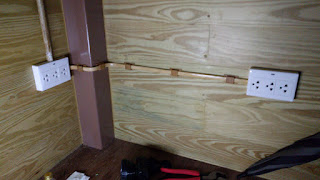The reason we have been using PVC conduit for most of our electrical wiring is that Praew always found the aluminum clips that one uses for mounting VAF wires to the wall ugly and cheap looking.
We went through all the effort of building a simple and rustic looking wooden house… so we are trying to make things like the electrical wiring blend in nicely to this style.
But after I started playing with 3D printing clips to run painted small gauge VAF wire for the LED lighting, Praew begin to reconsider.
So she let me use this approach to try running a short segment of the larger 4 square mm 3 conductor VAF wire between two outlets where the wire must go around a pole in the corner. Running this with PVC conduit would involve too many short segments and 90 degree turns, so bending the VAF around the corner was much simpler. Here is how it turned out:
First I printed a bunch of clips…
Then I painted the 3D printed clips with the same wood color stain that we use for the fiber cement decking (and we also use the same stuff to paint the PVC to look more like wood). Here is how it looks on the 3D printed clips made from plastic filament infused with wood:
The top one has a short piece of unpainted white VAF wire clipped in for test.
Rather than using screws, I am trying out using 3M VHB double sided tape to stick the clips to the wall. This tape is really sticky stuff. Under normal circumstances, I’m sure the clips will break apart before the tape comes off from the wall.
The main downside of using the VAF with clips instead of the PVC is that the PVC can be clipped on at 1m intervals or longer with no noticeable bending. But the VAF is softer so it needs clips roughly every 30cm. Just something to bear in mind.
So now I need to bring Praew by in the morning to see if she approves the look before deciding whether to go ahead and use this approach for some of the areas where PVC conduit is a pain.

